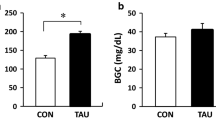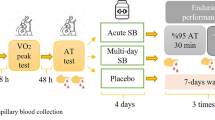Abstract
The effect of magnesium supplementation on exercise performance remains controversial. In the present study, the effects of magnesium sulfate on exercise performance and blood glucose metabolism were examined. In order to provide a non-invasive measure of continuous exercise, we developed an auto-blood sampling system was coupled to a microdialysis analyzer to detect the dynamic changes in glucose metabolism in conscious and freely moving gerbils subjected to forced swimming. Gerbils were pretreated with saline or magnesium sulfate (90 mg kg−1, ip) 30 min before exercise. The duration times were significantly increased by 71% in the magnesium sulfate-treated groups (p < 0.01) when compared with those in the control. Another group of gerbils were subjected to blood sampling assay. A catheter was implanted in the jugular vein of each gerbil for collecting blood samples by the computer-aided blood sampler. The basal levels of plasma glucose, lactate, and magnesium were 6,245 ± 662, 1,067 ± 309, and 590 ± 50 μM, respectively, with no significant difference between groups. Plasma glucose, lactate, and magnesium levels increased to 134 and 204%, 369 and 220%, and 155 and 422% of basal levels during swimming in both the control and magnesium sulfate-treated groups, respectively (p < 0.05). Pretreatment with magnesium sulfate elevated glucose and magnesium levels to 175 and 302% of the basal levels (p < 0.05), respectively, whereas pretreatment with magnesium sulfate reduced the lactate levels 150% of the basal level (p < 0.05) during swimming. Furthermore, the magnesium levels increased to about 152–422% of basal levels during forced swimming and the recovery period (p < 0.05). The present study demonstrates that magnesium sulfate improved the duration time of forced swimming exercise. In addition, magnesium raised glucose levels and attenuated lactate levels during forced swimming. These results indicate that positive effects of magnesium supplementation may contribute to the enhancement of exercise performance in athletes.





Similar content being viewed by others
References
Altura BM (1991) Basic biochemistry and physiology of magnesium: a brief review. Magnes Trace Elem 10:167–171
Bohl CH, Volpe SL (2002) Magnesium and exercise. Crit Rev Food Sci Nutr 42:533–563
Cheng SM, Yang DY, Lee CP, Pan HC, Lin MT, Chen SH, Cheng FC (2007) Effects of magnesium sulfate on dynamic changes of brain glucose and its metabolites during a short-term forced swimming in gerbils. Eur J Appl Physiol 99:695–699
Christensen SD, Mikkelsen LF, Fels JJ, Bodvarsdottir TB, Hansen AK (2009) Quality of plasma sampled by different methods for multiple blood sampling in mice. Lab Anim 43:65–71
Cinar V, Nizamlioglu M, Mogulkoc R, Baltaci AK (2007) Effects of magnesium supplementation on blood parameters of athletes at rest and after exercise. Biol Trace Elem Res 115:205–212
Clarkson PM (1991) Minerals: exercise performance and supplementation in athletes. J Sports Sci 9(Spec No):91–116
Clarkson PM (1995) Micronutrients and exercise: anti-oxidants and minerals. J Sports Sci 13(Spec No):S11–S24
Coggan AR (1991) Plasma glucose metabolism during exercise in humans. Sports Med 11:102–124
Contarteze RV, Manchado FD, Gobatto CA, De Mello MA (2008) Stress biomarkers in rats submitted to swimming and treadmill running exercises. Comp Biochem Physiol 151:415–422
Cordova A (1992) Changes in plasmatic and erythrocytic magnesium levels after high-intensity exercises in men. Physiol Behav 52:819–821
de Haan A, van Doorn JE, Westra HG (1985) Effects of potassium + magnesium aspartate on muscle metabolism and force development during short intensive static exercise. Int J Sports Med 6:44–49
Deuster PA, Singh A (1993) Responses of plasma magnesium and other cations to fluid replacement during exercise. J Am Coll Nutr 12:286–293
Deuster PA, Dolev E, Kyle SB, Anderson RA, Schoomaker EB (1987) Magnesium homeostasis during high-intensity anaerobic exercise in men. J Appl Physiol 62:545–550
Durschlag M, Wurbel H, Stauffacher M, Von Holst D (1996) Repeated blood collection in the laboratory mouse by tail incision—modification of an old technique. Physiol Behav 60:1565–1568
Ebel H, Gunther T (1980) Magnesium metabolism: a review. J Clin Chem Clin Biochem 18:257–270
Felig P, Cherif A, Minagawa A, Wahren J (1982) Hypoglycemia during prolonged exercise in normal men. N Engl J Med 306:895–900
Fitzner Toft M, Petersen MH, Dragsted N, Hansen AK (2006) The impact of different blood sampling methods on laboratory rats under different types of anaesthesia. Lab Anim 40:261–274
Gotoh M, Tajima T, Suzuki Y, Ikari H, Iguchi A, Kakumu S, Hirooka Y (1998) Swimming stress that causes hyperglycemia increases in vivo release of noradrenaline, but not acetylcholine, from the hypothalamus of conscious rats. Brain Res 780:74–79
Harms PG, Ojeda SR (1974) A rapid and simple procedure for chronic cannulation of the rat jugular vein. J Appl Physiol 36:391–392
Joborn H, Akerstrom G, Ljunghall S (1985) Effects of exogenous catecholamines and exercise on plasma magnesium concentrations. Clin Endocrinol (Oxf) 23:219–226
Komiya M, Takeuchi T, Harada E (2006) Lemon oil vapor causes an anti-stress effect via modulating the 5-HT and DA activities in mice. Behav Brain Res 172:240–249
Laires MJ, Alves F (1991) Changes in plasma, erythrocyte, and urinary magnesium with prolonged swimming exercise. Magnes Res 4:119–122
Laires MJ, Alves F, Halpern MJ (1988) Changes in serum and erythrocyte magnesium and blood lipids after distance swimming. Magnes Res 1:219–222
Laires MJ, Madeira F, Sergio J, Colaco C, Vaz C, Felisberto GM, Neto I, Breitenfeld L, Bicho M, Manso C (1993) Preliminary study of the relationship between plasma and erythrocyte magnesium variations and some circulating pro-oxidant and antioxidant indices in a standardized physical effort. Magnes Res 6:233–238
Lijnen P, Hespel P, Fagard R, Lysens R, Vanden Eynde E, Amery A (1988) Erythrocyte, plasma and urinary magnesium in men before and after a marathon. Eur J Appl Physiol Occup Physiol 58:252–256
Lin YC (1988) Applied physiology of diving. Sports Med 5:41–56
Lin JY, Chung SY, Lin MC, Cheng FC (2002) Effects of magnesium sulfate on energy metabolites and glutamate in the cortex during focal cerebral ischemia and reperfusion in the gerbil monitored by a dual-probe microdialysis technique. Life Sci 71:803–811
Lukaski HC (2000) Magnesium, zinc, and chromium nutriture and physical activity. Am J Clin Nutr 72:585S–593S
Lukaski HC, Nielsen FH (2002) Dietary magnesium depletion affects metabolic responses during submaximal exercise in postmenopausal women. J Nutr 132:930–935
Mooren FC, Golf SW, Lechtermann A, Volker K (2005) Alterations of ionized Mg2+ in human blood after exercise. Life Sci 77:1211–1225
Nielsen FH, Lukaski HC (2006) Update on the relationship between magnesium and exercise. Magnes Res 19:180–189
Philp A, Macdonald AL, Watt PW (2005) Lactate—a signal coordinating cell and systemic function. J Exp Biol 208:4561–4575
Poleszak E, Wlaz P, Szewczyk B, Kedzierska E, Wyska E, Librowski T, Szymura-Oleksiak J, Fidecka S, Pilc A, Nowak G (2005) Enhancement of antidepressant-like activity by joint administration of imipramine and magnesium in the forced swim test: Behavioral and pharmacokinetic studies in mice. Pharmacol Biochem Behav 81:524–529
Poleszak E, Wlaz P, Wrobel A, Fidecka S, Nowak G (2008) NMDA/glutamate mechanism of magnesium-induced anxiolytic-like behavior in mice. Pharmacol Rep 60:655–663
Rama R, Ibanez J, Pages T, Callis A, Palacios L (1993) Plasma and red blood cell magnesium levels and plasma creatinine after a 100 km race. Rev Esp Fisiol 49:43–47
Rayssiguier Y, Guezennec CY, Durlach J (1990) New experimental and clinical data on the relationship between magnesium and sport. Magnes Res 3:93–102
Saris NE, Mervaala E, Karppanen H, Khawaja JA, Lewenstam A (2000) Magnesium. An update on physiological, clinical and analytical aspects. Clin Chim Acta 294:1–26
Stendig-Lindberg G, Shapiro Y, Epstein Y, Galun E, Schonberger E, Graff E, Wacker WE (1987) Changes in serum magnesium concentration after strenuous exercise. J Am Coll Nutr 6:35–40
Szabo MD, Crosby G (1988) Effect of profound hypermagnesemia on spinal cord glucose utilization in rats. Stroke 19:747–749
Weight LM, Myburgh KH, Noakes TD (1988a) Vitamin and mineral supplementation: effect on the running performance of trained athletes. Am J Clin Nutr 47:192–195
Weight LM, Noakes TD, Labadarios D, Graves J, Jacobs P, Berman PA (1988b) Vitamin and mineral status of trained athletes including the effects of supplementation. Am J Clin Nutr 47:186–191
Acknowledgments
This study was supported by grants from the National Science Council (NSC-97-2113-M-468-001-), Taiwan, and the Taichung Veterans General Hospital and The Overseas Chinese Institute of Technology (TCVGH-OCIT-978401), Taiwan, ROC. We also thank the Biostatistics Task Force of TCVGH for their assistance with the statistical analyses.
Author information
Authors and Affiliations
Corresponding author
Additional information
Communicated by Susan Ward.
Rights and permissions
About this article
Cite this article
Cheng, SM., Yang, LL., Chen, SH. et al. Magnesium sulfate enhances exercise performance and manipulates dynamic changes in peripheral glucose utilization. Eur J Appl Physiol 108, 363–369 (2010). https://doi.org/10.1007/s00421-009-1235-y
Accepted:
Published:
Issue Date:
DOI: https://doi.org/10.1007/s00421-009-1235-y




